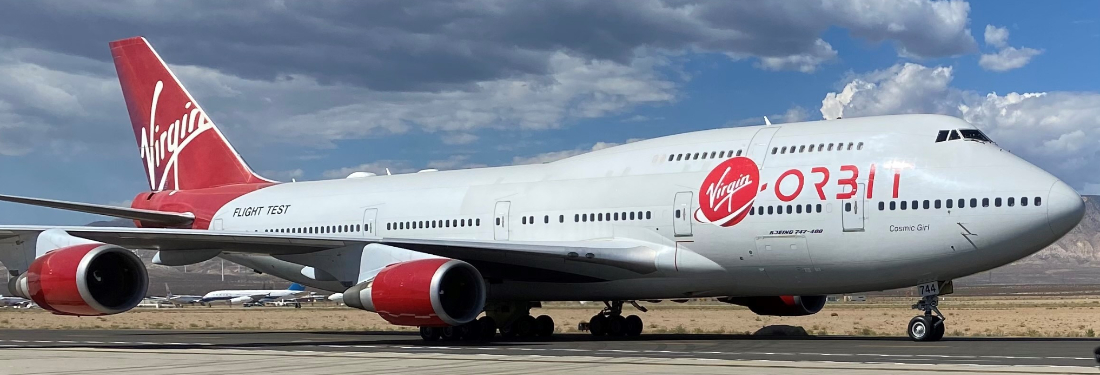Bouncing back from Virgin Orbit’s ill-starred rocket launch project

On 9 January, the Irish government issued a warning to maritime traffic off the country’s south-western coastline: “There is a low probability for the vehicle to produce dangerous debris if a mishap were to occur.”
The “vehicle” was a rocket, LauncherOne, carrying nine small satellites whose intended destination was 500km above Earth’s surface. The plan was to fire the rocket after it had been carried to an altitude of 35,000ft under the wing of a 747 jet, owned by Virgin Orbit, that departed from Newquay airport in Cornwall shortly after 10pm.
In the event, the coastguard’s warning proved prophetic. Virgin Orbit’s official statement explains what happened.
“After successfully taking off from the runway… Cosmic Girl, the customized 747 that serves as the LauncherOne system’s carrier aircraft, successfully released the rocket.
“It then ignited its engines, quickly going hypersonic and successfully reaching space. The flight then continued through successful stage separation and ignition of the second stage. However, at some point during the firing of the rocket’s second-stage engine and with the rocket travelling at a speed of more than 11,000 miles per hour, the system experienced an anomaly, ending the mission prematurely.”
“Newquay, we have a problem…”
The language (“experienced an anomaly”) is typically euphemistic for the space industry, and the company understandably accentuates the positive elements of the project’s launch. But, as any project manager working at the limits of engineering knows, failures are part and parcel of programme development.
“There was clearly a malfunction, but the causes aren’t yet clear,” explains Matthew Archer, Director, Commercial Spaceflight, at the UK Space Agency (UKSA). “Of course, you collect a lot of data, but it rarely contains a neat answer. The investigation aims to explore the evidence and recommend any necessary corrective changes for the programme.”
Daniel Smith, Director of space marketing firm AstroAgency, was watching a live broadcast of the launch. “I actually turned off the stream, assuming it had gone to plan,” he says. “The failure was very late in the process. Remember, this system has seen four successful launches from California before now, so it’s just very unfortunate this particular launch was the one that ran into trouble.”
Programme, not project
What both Archer and Smith are keen to emphasise is that while the first orbital launch from the UK is something of a milestone, actually getting the payload space-bound is just a tiny part of a much bigger programme.
“Many projects had to come to fruition just to deliver this launch,” says Smith, stressing that they provide the foundation for a burgeoning UK launch industry.
“We had to come up with a whole raft of new legislation and regulations to govern spaceflight,” adds Archer. “We had to secure international agreements for vehicles overflying other countries; we had to develop the infrastructure at Spaceport Cornwall; and there are the R&D investments to ensure the benefits of these new capabilities are realised. All of that is a massive success for the programme.”
And while a technical post-mortem will be important for the Virgin Orbit project team, maintaining the momentum of the programme is as much about human factors as high-performance engineering.
“For UKSA and the project leaders in the space industry, it comes down to how you help people regroup,” Archer says.
“That’s a really important part of any project: you have to look after each other and recognise this is where a team needs to come together and look at what worked. If you want to be a mature space nation, you have to be able to say, ‘these things happen’, when you are trying something creative.”
Future projects: 10…, 9…
In fact, the UK’s status in the space industry pre-dates this launch. The UK is the biggest producer of satellites outside the US, for example. With vertical launch spaceports under construction in Shetland and Sutherland, and a carrier-launch facilities in Scotland and Wales to augment Spaceport Cornwall, future projects are well catered for.
The UK is particularly well placed to launch the types of satellite that are in high demand and form much of the £2bn-a-year launch market.
“Northern latitudes are ideal for polar and geosynchronous orbits,” explains Smith. “There are so many projects that require Earth observation satellites in those orbits – from monitoring climate change and subsurface water flows to identifying crop diseases and even tracking endangered species.”
And although this LauncherOne project mishap was a setback, one rocket – even the first launched from the UK – is not a critical dependency for the UK launch programme. The regulations, ground infrastructure and burgeoning skills base are.
“And this launch did serve a crucial purpose in inspiring others,” Archer concludes. “We’ve demonstrated that the UK can launch vehicles into space – and we’ve created an opportunity for young people to be inspired to come into the sector. It’s important to remind yourself of the huge benefit from this project.”
You may also be interested in:
- Sharing knowledge and learning lessons in APM Learning
- Project lessons from the world’s worst maritime oil spill
- How a British company launched a green, clean hybrid rocket engine
Image: Cosmicgirl taxi for takeoff, Virgin Orbit


0 comments
Log in to post a comment, or create an account if you don't have one already.